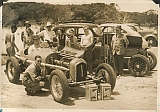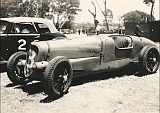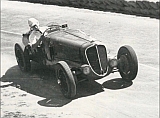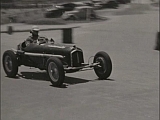| HISTORY | TEAMS and DRIVERS | VEHICLES | RECORDS | EVENTS | LOCATIONS | LINKS | CONTACT US |
| Coorong Speed Records | ||
| South Australia |
 The Jack Saywell Alfa Romeo Tipo B/P3 and John Snow Delahaye 135CS and friends at The Coorong, South Australia on January 5 and 6 1939  Not the Coorong but the Lobethal paddock earlier in the week- John Snow’s gorgeous Delahaye 135CS- he used the Hudson behind in the Australian Stock Car Championship that weekend too (N Howard)    John Snow during the 1939 AGP weekend at Lobethal, Delahaye 135CS (N Howard)  Jack Saywell, Alfa Romeo Tipo B, AGP Lobethal 1939 |
|
The two intrepid Sydney racers contested the 1939 Australian Grand Prix at Lobethal on 2 January, the handicap race famously won by Allan Tomlinson in his MG TA Spl s/c. Saywell aboard ‘the fastest car in Australia’ was off scratch and finished sixth, slowed by tyre problems on the scorching hot South Australian summer day. Snow was off 4 minutes 15 seconds in the French sportscar and was fourth. Everybody that day was outfoxed, out-prepared and outraced by the three youngsters from Perth- Tomlinson and two fellow racer/fettlers Clem Dwyer and Bill Smallwood. Whilst in South Australia they decided to attack some Australian speed records on the pipe-clay surface of The Coorong, at a little spot near Salt Creek, 210 km from Adelaide. Huge amounts of preparation went into the attempts with the Sporting Car Club of South Australia playing an organisational role and in ensuring compliance with international rules. Whilst attempts were being made by Snow and Victorian racer Lyster Jackson over longer distances/times, both Snow and Saywell also wanted a crack at The Flying Mile (Class C for Snow and Outright for Saywell) which had to be timed to the nearest hundredth of a second rather than a tenth of a second- the best which could be achieved with a chronometer. The Adelaide University Physics Department were involved in creating some automatic photo-electric timing equipment which met the accuracy requirements of the international regulations. Two existing speed records had been set in South Australia during February 1935 at Sellicks Beach by John H Dutton (Class C 92 mph Flying Mile) and CW Bonython MG (Class A 76.09 mph) but the Fleurieu Peninsula beach would not suffice in length for this endeavour which sought records between an hour and twenty-four hours. A huge open area was needed with space for long, high speed corners to keep average speeds up. Whilst the opening photo may be at the Coorong, it could be at Sellicks- perhaps its a promotional shot taken prior to the record attempts or maybe a test run. Let me know if you have certainty about the locale. Weather delayed the attempts by a few days but the SCCSA officials were out and about at 5 am on the morning of Thursday 5 January 1939 and prepared a surface as ‘smooth as glass’- the wind was up on the day and was said to be anything up to a 40 mph headwind. The temperature was 96 degrees Fahrenheit, by the end of the week the temperature in Adelaide was 117 degrees! ‘Despite that a crowd of over 200 people ventured out into that desolate landscape and into those incredible temperatures, setting up a tent city’ wrote John Medley. The chosen course had been professionally surveyed by an SCCSA club-member and measured 10 miles 318 yards- it was a huge oval comprising two straights of 5 miles and ‘wide circles at either end for turning’. John Snow started the blue Delahaye 135CS at noon and was soon lapping consistently, the intent being to stick to a plan to coax the car through 24 hours- it wasn’t a sprint after all. John covered the first 185 miles in just over two hours averaging 92 mph. The car was then refuelled in 4 minutes and Lyster Jackson jumped aboard- he maintained the average of 92 mph in his 10 lap stint and then made another refuelling stop and some ‘engine adjustments’ were made. The first tyre stop, which took 49 seconds, was made a little later and then Jackson was relieved by Snow after the speedy machine had completed 35 laps, or about 366 miles. Snow had been going again for less than 3 miles when valve trouble ended further motoring at about 6.30 pm. A perfect world would have been popping a spare engine into the car between the 150 mile Grand Prix and the record attempt but Snow didn’t have a spare despite his wealth. The car ‘was overhauled by the Englishman brought to Australia specially to prepare the car’- lets come back to that point. The distance travelled in the first hour was 92 miles, for three hours about 275 miles. Jackson did the quickest lap at 6:26 with Snow’s 6:32. ‘No attempt was made to push the car’ but a mean speed of 130 mph was reached on the long straights. The team claimed records to the Australian Automobile Association for 50, 100 and 200 miles- 50, 100, 200 and 500 kilometres- and 1 and 3 hours. Those recognised in the Australian record books are; Standing 100 km 40 mins 45.5- 91.47 mph, Standing 200 km 1 hour 21.29.0- 91.51 mph, Standing 50 Miles 32.55.4- 91 mph, Standing 100 Miles 6:5.33.0- 91.51 mph. Obviously the Delahaye was in no fit state to attack the Flying Mile, whilst one newspaper report has it that Saywell’s Vittorio Jano designed masterpiece did 132 mph for the Flying Mile and 88 mph for the Standing Mile. ‘On the following day , it was Jack Saywell’s turn…the task was perhaps simpler, the red car attacking only two records, the standing start and flying start mile- but the blistering temperature, sandy surface and blustery 45 mph sidewind across his path were going to be a hindrance…in accordance with AAA rules, a run in each direction was required, and the Alfa used its Lobethal rear axle ratio, the second highest of four available’ John Medley wrote. ‘Using a four mile run in against the breeze, Saywell averaged 128 mph for the first officially timed run. In the opposite direction he used a shorter run in and averaged 140 mph for the flying mile. The average of the two runs was 134.7 mph, the fastest officially recorded speed in Australian history breaking the previous record by over 35 mph’. ‘The Alfa was then prepared for its attempt on the standing start one mile record. Spewing dirt off its spinning back wheels for the first 400 yards, the booming Alfa then got into its stride and crossed the line at 142 mph, wind assisted. Into the wind Saywell crossed the finishing line at 125 mph. When the times were totalled and the speed averaged, the mean speed was 89.2 mph, another new Australian record’ John Medley wrote. Some Australian enthusiasts will be aware that John Snow, scion of the wealthy Sydney ‘Snows Department Stores’ family made annual trips to the UK both to purchase merchandise for the family business and to race and purchase some top-end cars either to order or for re-sale back in Oz. The 1939 AGP grid, for example, comprised at least four cars (John Crouch Alfa 8C2300 Le Mans, Colin Dunne MG K3 Magnette, Saywell’s Tipo B and Snows Delahaye 135CS) imported to Australia by the front-rank Sydney racer. The Delahaye was a remarkably astute purchase by Snow for Australian handicap racing- it was not an outright winner other than on the ‘right day’ but with enough speed and reliability built into it by virtue of its sports-racer intent would always be ‘thereabouts’ in the handicaps which predominated in Australia. And so it was, mainly. The car probably coulda-shoulda won several AGP’s, but in the end it only took the one, in John Crouch’s hands at Leyburn, Queensland in 1949. The 6 cylinder, 3557cc, OHV 160 bhp car, chassis ‘47190’ was turned into a ‘corn-chip’ as a consequence of a disastrous trailer fire due to an errant cigarette butt flicked out of the car window upon the trip back to Sydney after the 1951 AGP at Narrogin, Western Australia. Enough of the car existed to reconstruct in the seventies/eighties. The English mechanic referred to earlier was ‘Jock’ Finlayson, he was brought to Australia by Snow and Saywell who by that time were operating ‘Monza Service’, at 217 Bourke Street, East Sydney looking after various racing and top-end road cars. The very well credentialled (ex-Bentley, Birkin, Straight, Seaman) poor chap totally stuffed up the timing of Saywell’s 2.9 litre, DOHC, supercharged Tipo B engine when he rebuilt it and rooted the engine as a consequence. With no confidence in anyone else locally to address the engine and having plenty of moolah Jack popped the engine onto a boat back to Milan, but the ship is thought to have been sunk in the immediate months of the War- Saywell never saw that engine again! Chassis ‘5002’ was not reunited with a motor of kosher original specification until it was restored in Australia in the early sixties. It had an active, long, eventful racing career mind you, albeit fitted with GMC and Alvis motors… Credits… Fred Pearse Collection, ‘John Snow: Classic Motor Racer’ John Medley, Norman Howard from the Bob King Collection Taken from the pages of PRIMOTIPO |
||
Learn More |
||
|
|